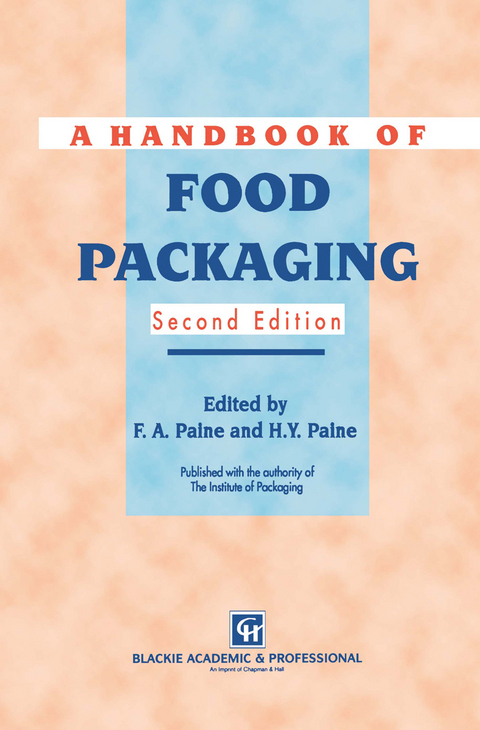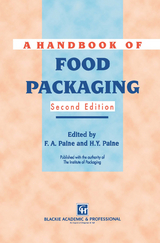A Handbook of Food Packaging
Kluwer Academic / Plenum Publishers (Verlag)
978-0-216-93210-4 (ISBN)
1 Introduction to packaging.- History.- Definitions.- The need for packaging.- Designing successful packaging.- Packaging materials selection and machinery considerations.- The place of packaging within the marketing complex.- Properties and forms of packaging materials.- Food process classification.- References.- 2 Graphics and package design.- Management’s role.- Packaging and modern merchandising.- Meeting customer and consumer needs.- Beware the half truth and consider the alternative.- Trends.- Summary of consumer needs.- The function of packaging graphics.- The main printing processes.- Factors affecting the choice of a printing process.- References.- 3 Notes on packaging materials.- Paper-based packing.- Plastics.- Glass containers.- Metal packaging: the basic materials.- Natural materials.- References.- 4 Packaging machinery.- Production and packaging line requirements.- The property profile.- Bottling.- Canning operations.- Wrapping operations.- Cartoning.- Form, fill and sealmachines.- Labelling.- Standard case sealing, wrap-around case sealing and tray erection.- Organization of packing lines.- Further reading.- 5 Packaging for physical distribution.- Fibreboard case performance.- Unitizing methods.- References.- 6 Spoilage and deterioration indices.- Biodeterioration.- Abiotic spoilage.- References.- 7 Fresh and chilled foods: meat, poultry, fish, dairy products and eggs.- Meat.- Poultry.- Fish and shellfish.- Milk.- Other dairy products.- Dairy spreads.- Eggs.- Cream.- Guidelines for packers, manufacturers, distributers and consumers.- References.- 8 Fresh fruits and vegetables (including herbs, spices and nuts).- Fruits and vegetables.- Fresh herbs and spices.- Nuts and seeds.- References.- 9 Frozen foods.- Freezing.- Frozen meat and poultry.- Frozen fish.- Frozen fruits and vegetables.- Other frozen products.- Guidelines for packers, distributors, retailers and consumers.- Future trends.- References.- 10 Heat-processed foods (including irradiated foods, etc.).- Heat processing.- High-barrier plastics packaging.- Aseptic processing.- Sous vide.- Packaging for microwavable foods.- Irradiation.- Ultraviolet light.- Ultrasonics.- High pressure techniques.- References.- 11 Dried and moisture sensitive foods.- Reduction of available water.- Active packaging systems.- References.- 12 Other processed foods.- Preservation by chemical means.- Fermented foods.- Fats and oils.- References.- 13 Juices, soft drinks and alcoholic beverages.- Fruit juices and beverages.- Beers and ales.- Cider.- Wine.- Distilled spirits.- References.- 14 Developing packs for food.- The product life cycle.- Planning for change.- Basic considerations for package development.- Developing a domestic food packaging for an export market.- References.- 15 The economics of primary packaging.- Cost comparisons.- The economics of the glass primary package.- The economics of cans and canning.- The economics of cartons.- The economics of packaging with flexible materials.- References.- 16 Using barrier materials efficiently.- Transmission of gases and vapours through barrier materials.- Pests.- The compatibility of foods with their packaging.- References.- 17 Specification and quality control.- What is quality?.- Quality control.- Measurement, the assessment of quality.- Factors affecting quality in packaging.- Quality assurance.- References.- Further reading.- 18 Evaluation and testing of transport packages.- Methods of evaluation.- Journey hazards.- The effect of environment on packages.- Package test equipment.- Methods of using tests.- References.- Appendices.- Appendix 1 European packaging legislation.- Appendix 2 USA legislation.
| Zusatzinfo | XIV, 497 p. |
|---|---|
| Verlagsort | Dordrecht |
| Sprache | englisch |
| Maße | 155 x 235 mm |
| Themenwelt | Sozialwissenschaften ► Kommunikation / Medien ► Journalistik |
| Technik ► Lebensmitteltechnologie | |
| Wirtschaft | |
| ISBN-10 | 0-216-93210-6 / 0216932106 |
| ISBN-13 | 978-0-216-93210-4 / 9780216932104 |
| Zustand | Neuware |
| Haben Sie eine Frage zum Produkt? |
aus dem Bereich




